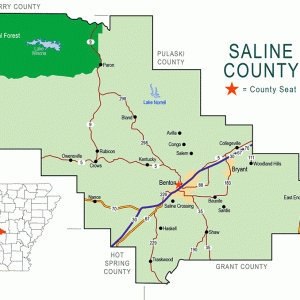calsfoundation@cals.org
Collegeville (Saline County)
Collegeville is one of Arkansas’s oldest unincorporated communities and the oldest in Saline County. The area was first settled by a group of planters led by Major Ezra Owen in an area between present-day Bryant (Saline County) and Alexander (Pulaski and Saline counties) in 1824, when Arkansas was still a frontier territory. In the twenty-first century, the community of Collegeville lies alongside State Highway 5 and Interstate 30, less than twenty miles from Little Rock (Pulaski County).
Ezra Owen was born in Halifax County, Virginia, on March 17, 1770. He served with distinction in the War of 1812 with the Illinois Rangers before he moved to what was then Arkansas Territory. He supposedly served with frontiersman Daniel Boone in the Indian Wars in what is now the Commonwealth of Kentucky, achieving the rank of major. Owen married a woman named Lydia Vance on July 16, 1793, when he was twenty-three and she was apparently only thirteen.
After Arkansas Territory was established in 1819 and the subsequent influx of new settlers began, it became apparent that a new site would be needed for the state capital should Arkansas attain statehood. On forty acres of land he set aside, Owen intended to build the state capital city and the home of the first state college; therefore, he named the new settlement Collegeville in 1835; before that, it was known as Dogwood Springs and was the site of Saline County’s first post office. Enough people had settled in the new town by the 1830s that it was one of several places reportedly under consideration to replace Arkansas Post as the official state capital, though Little Rock was soon chosen by the territorial legislature.
Owen had arrived in Arkansas Territory sometime between 1823 and 1825. In 1840, the total population of Owen Township (Collegeville) was 481 altogether, 398 free whites and 83 slaves. The Owens had several children; a daughter, Lydia Echols Owen, married Andrew Marion Dodd at Collegeville on April 27, 1843. The Dodds’ son, David Owen Dodd, was born in Lavaca County, Texas, on November 10, 1846. David O. Dodd was captured by Union troops and hanged as a spy in Little Rock in 1864, going on to be hailed as the “Boy Martyr of the Confederacy” in post–Civil War Arkansas.
Although he failed to make Collegeville the home of the state’s first college or its new capital, Ezra Owen and his family stayed in the area for many years. The town of Collegeville grew to include its own church and attracted several hundred people to form what became Saline County by 1835. That same year, Owen was elected doorkeeper of the House of Representatives by the Territorial Legislature. Owen immigrated to Texas in 1846, a year after it had attained statehood, presumably to take advantage of the newly opened territory. Owen, the founder of Collegeville—and, to some extent, a founder of Saline County—died on December 11, 1859, at his home in Lavaca County at the age of ninety.
During the American Civil War, a minor skirmish took place in the Collegeville area at nearby Hurricane Creek on October 23, 1864. In the 1870s, the St. Louis and Iron Mountain Railroad brought an economic and population boom to Saline County. The community of Bryant Township split off from the larger Owen Township (Collegeville) in 1878, when the Bryant Train Depot opened. In 1892, Bryant became an incorporated town. In the twentieth century, after the devastation of the Great Depression in the 1930s, the communities of Collegeville, Benton (Saline County), Bryant, and Alexander grew immensely, especially after the Alcoa and Reynolds Aluminum plants became economic epicenters in the county until after World War II.
Interstate 30 was built through the area in the 1950s, allowing many communities to become suburbs of Little Rock. Collegeville, Bryant, Benton, and Alexander have become home to many who commute to the state capital.
Despite the growth of the Collegeville area, it was never incorporated as an official town. Today, the area where the Owen family and their followers settled is largely contained within the Bryant city limits. Collegeville Elementary on Highway 5 is named in Collegeville’s honor, even though it is not located near the site of the original town. The Geographic Center of Arkansas Marker is located nearby.
For additional information:
Billingsley, Carolyn J. “Collegeville Owen Township.” In Saline County: Recollections of Early Settlers, edited by Ruth Fleming Beaty. Benton, AR: Gann Museum, 1986.
Billingsley, Carolyn Earle. “Settlement Patterns in Saline County, Arkansas.” Arkansas Historical Quarterly 52 (Summer 1993): 107–128.
“Collegeville Is Oldest Village in Saline County.” Benton Courier Centennial Edition, 1836–1936. March 25, 1937, p. 21.
Cody Lynn Berry
University of Arkansas at Little Rock
 Saline County Map
Saline County Map 




Comments
No comments on this entry yet.